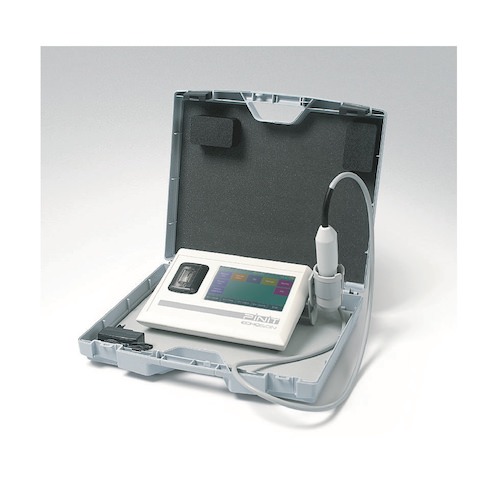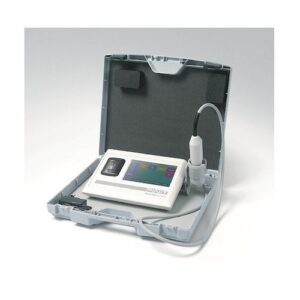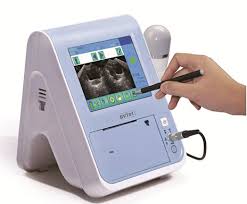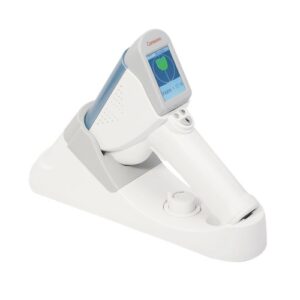Description
PINIT – Portable Bladder Ultrasound Scanner (PBUS), is medical device dedicated for quick, accurate non-invasive bladder volume contents measurement,
and also for basic exams and measurement of urinary organs and tracts.
Most common medical fields:
- urinary incontinence /PVR/
- urinary retention /POUR, AUR, CUR/
- uroflowmetry (urodynamics) support
- monitoring post-operative recovery
- to assess effectiveness of mechanical bladder emptying
- as a standard investigation for at-risk groups with urinary problems
- to determine bladder volume if catheter not draining or is blocked
- to identify any voiding problems prior to an invasive procedure
Advantages:
- limitation of unnecessary catheterization
- reduce catheter-associated urinary tract infections (CAUTI)
- non-invasive, no pain or discomfort
- instantaneous results
- help in managing incontinence
- enables wide-range diagnose and measurements of bladder, kidneys, prostate etc.
- easy and suitable for use with children and adults
- cost reduction and saving staff time
Urodynamics support:
– kidneys and bladder exams for infection/ inflammation absence confirmation (B-mode visualization)
– bladder filling confirmation and measurement – before and after uroflowmetry test
Sophisticated and unique features
- bladder contents automatic estimated volume measurement – quick execution: single-click + 2 sec. = result
- semi automatic – multipoint/trace contoured volume measurement – unique and excellent method for often appeared “difficult cases” and small volume bladders
- professional mod WYSIWYG: What You See Is What You Get – non-blindfold measurements (real-time pre-scan)
- diagnostic scanning mode – classical B-mode visualization, for urology (kidneys, bladder) and general abdominal exams
- able to be assessed in the home or community setting
- touch-screen operation, easy and convenient for measurement and control.
Used abbreviations:
PVR – Post Void Residual ; AUR – Acute Urinary Retention; CUR – Chronic Urinary Retention; POUR – Post Operative Urinary Retention
Specifications
Bladder Volume (BV) measurement
- Probe operating main frequency: 2.5 – 5.0 MHz
- Automatic bladder volume measurement (based on Echo-Son 3D technology)
- Automatic displaying of the bladder contour on the live image
- Automatic displaying of the estimated bladder volume in real time during scanning
- Two automatic modes : QUICK for estimating volume, and AUTO for measurement volume.
- Additional semi-automatic methods: multi-point, continuous outline, 3-axis method HWL
- Applications: for Male, Female and Children
- Volume range in automatic modes: 0..999ml
- Volume range in semi-automatic modes: 0..1499 ml
- One button operated
B – mode application
- B – mode visualization: sector, scanning angle 120°
- Scanning depth: 13 .. 23 cm
- Optimized probe operating frequency: 3.2 MHz
- Distance measurement with two pairs of pointers
- Volume and area measurement ( ellipse method)
General features
- hi-res colour LCD 7″ display
- easy-to-use, intuitive operation via touch screen
- fast start of the device (ca. 6 sec)
- scanning range: 10-23 cm
- adjustment of display brightness
- possibility of selecting 10 users (operators)
- internal patient’s database
- data entered via touch screen keyboard
- possibility of connecting an external alphanumeric keyboard
- support for barcode reader
- build-in thermal printer
- internal memory and pen drive mass-storage
- support of multiple languages – possibillity to add another menu language
- composite video output (optional)
- easy software upgrade via USB
Power supply
- Power supply from an internal long-lasting battery or external power adapter
- External AC/DC adaptor :
– input:100-230V AC 50/60Hz/ max 0.7A
– output: +12V DC/2 A - Internal battery:
– battery module Li-Ion , 2600 mAh
– working time on batteries ca 8 hours (typical exams and measurement procedures)
– quick charging of batteries even while the device is in operation
– monitoring the battery status and charging progress
– power consumption (battery supply) – ca 12 W
Electrical safety standards
– Medical device Class IIa complies with MDD 93/42 EEC
– Scanner complies with requirements for Class II devices of EN/IEC 60601-1
Weight and dimensions
- Dimensions (with built-in printer): 290 x 205 x 85 mm
- Weight (with built-in printer): 1.4 kg
- Overall weight (with transport suitcase) : ~ 2.6 kg
PINIT-PC software (optional)
- a special software that enables management of the patient database and measurements (images) obtained from PINIT scanner.
- it can be installed in any external PC computer, tablet etc. operated by Windows.
- exchange of images and patient data between a scanner and the PINIT-PC application is done using an USB memory or via a direct USB connection.
- possibility to print on any printer the special report of exams
- additional option – possibility to use the standard DICOM 3.0 to communicate with PACS/RIS systems (Store, Print, Worklist).




